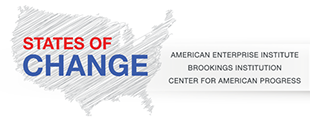


CAP, AEI, and Brookings release new report from States of Change project at event exploring how demographic shifts in race, age, and generation could affect future election outcomes (from 2016 to 2032)
Washington, D.C. — Today, the Center for American Progress; the American Enterprise Institute, or AEI; and the Brookings Institution released a new report and interactive with simulations that examine how demographic shifts by race, age, and generation could affect election outcomes from 2016 to 2032. The simulations—which offer a range of outcomes that can be expected under different assumptions as the nation’s demography changes—use projections produced and presented by the States of Change project in 2015, a groundbreaking collaboration between CAP, AEI, and Brookings.
The findings are being presented during an event held today at AEI, titled “States of Change: The Electoral and Policy Implications of Demographic Change.” A livestream of the event can be accessed here.
The authors of the report, titled “America’s Electoral Future: How Changing Demographics Could Impact Presidential Elections from 2016 to 2032,” assert that while the study assesses the potential electoral effects of shifting race and age demographics under a variety of different scenarios—and while this effect is likely to be significant—the simulations reveal that neither party can be assured of long-term dominance simply from shifting demographics.
The analyses presented considers the following six main scenarios:
- The “2012 Forward scenario,” which assumes that the voter turnout rates and Democratic/Republican candidate preferences for each racial group in 2012 will continue for eligible voter populations that are projected into the future.
- The “2008 Forward scenario,” which assumes that the even more Democrat-favorable turnout and candidate preference for each racial group in 2008 will apply to future eligible voter populations.
- The “2004 Forward scenario,” which assumes that the relatively Republican-favorable 2004 turnout rates and candidate preferences for each racial group will apply to future eligible voter populations.
- The “Maximum Minority Turnout scenario,” which assumes that the turnout of Hispanics, Asians, and other races by age rises to the turnout level of whites by age in every state. This simulation shows the likely outcomes that would result if efforts to encourage the turnout of newer minorities—Hispanics, Asians, and other nonblack minorities—are extremely successful.
- The “High GOP Hispanic/Asian Support scenario,” which assumes that Republican support from voters of each nonblack or new minority group—Hispanics, Asians, and those of other races—will increase by 7.5 percentage points for those groups in every state.
- The “More GOP White Support scenario,” which changes the voting preferences of the white electorate, adjusting scenario A in order to increase the level of Republican support from white voters of all age categories in every state by 5 points—thereby raising the GOP margin among white voters by 10 points.
“Demographics may not be destiny, but they do play a significant role in shaping the future,” said Ruy Teixeira, Senior Fellow at the Center for American Progress and co-author of the report. “An older and more racially diverse voter population will reshape the American political landscape, and both Democrats and Republicans will need to grapple with that reality.”
“In election years, candidates, issues, and the voters’ mood always matter. But demographic change is centrally important, too, and the States of Change project has been examining how it will affect elections going forward and policy choices the nation will have to make,” said Karlyn Bowman, senior fellow and research coordinator at the American Enterprise Institute. “The AEI, Brookings, and CAP collaboration provides an excellent foundation for these discussion.”
“Changing demographics across the 50 states will have a huge impact on the results of the 2016 election and beyond,” said William H. Frey, senior fellow at the Brookings Institution and a co-author of the report. “Unlike in the primaries, both parties will need to come to grips with a more racially diverse nation in order to capture the White House in the general election. These projections will give Republicans and Democrats a valuable tool for assessing the future.”
In year two of the States of Change Project, the project’s leaders commissioned six papers on the policy implications of the demographic changes—two each from different political perspectives on the significance of the changes for the family; for the economy and workforce; and for the social contract. Their discussions include public policy responses to topics such as strong correlations between family structure, educational attainment, and race, as well as possible conflicts of interest between an aging white population and a more diverse workforce over the financing and extent of social programs. Authors include Jared Bernstein of the Center on Budget and Policy Priorities, Henry Olsen of the Ethics & Public Policy Center, Naomi Cahn of the George Washington University Law School, June Carbone of the University of Minnesota Law School, Howard Lavine of the University of Minnesota, David Blankenhorn of the Institute for American Values, William Galston of the Brookings Institution, and Reihan Salam of the National Review Institute.
For more information or to speak to an expert on this topic, please contact Tanya S. Arditi at [email protected] or 202-741-6258.
###
AEI is a nonprofit, nonpartisan public policy research organization that works to expand liberty, increase individual opportunity, and strengthen free enterprise.
The Brookings Institution is a nonprofit organization devoted to independent research and policy solutions. Its mission is to conduct high-quality, independent research and, based on that research, to provide innovative, practical recommendations for policymakers and the public.